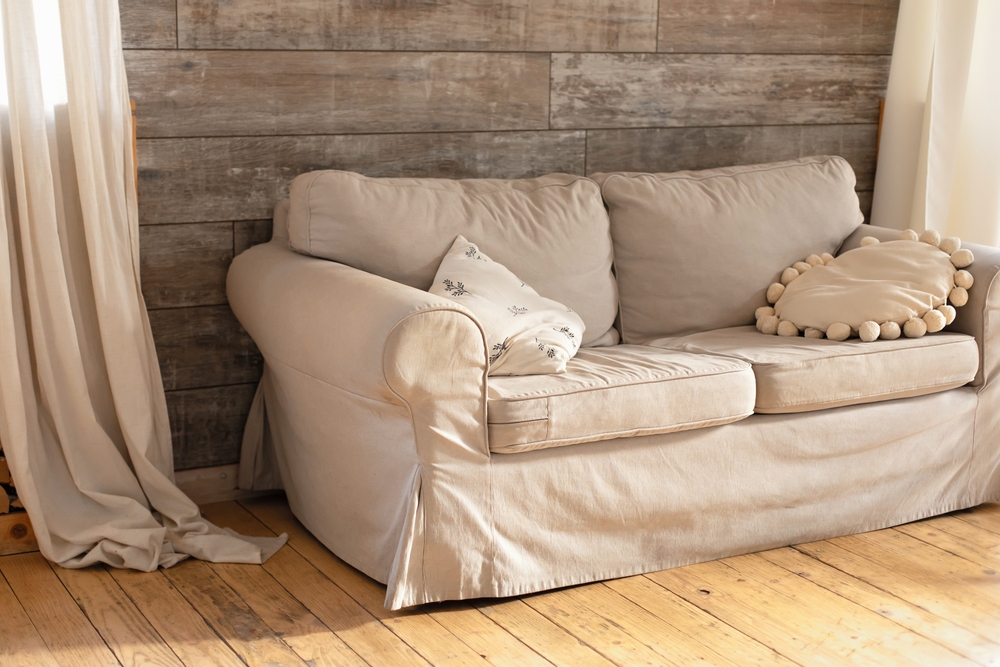Find the couch that best suits your lifestyle, comfort preferences, and style
Choosing the right couch is an important decision as it plays a significant role in the comfort and look of your living space, so your choice should reflect your preferences and needs.
In order to buy the right sofa, you need to consider how it will be used, the style and shape that will best complement your decor, and the ideal size.
Our furniture experts have explained the five essential things to consider when choosing the right couch, ensuring you are satisfied with your choice long-term. By following these tips you can find the best couch for your space, whether it is a living room sofa, or an addition to a bedroom or family room.
Essential things to consider to choose the right couch
As the focus of many living spaces, your choice of couch is a significant investment, so it is important to do your research to find the perfect one for your household.
1. The fabric
Choosing the right fabric for your sofa is crucial and should largely be determined by the circumstances of your household. Take into account the amount of wear and tear the couch will receive, the level of maintenance you are willing to undertake, the overall aesthetic you want to achieve, as well as your lifestyle.
‘Research the quality of the fabric type that you will choose, such as maintenance recommendations and cleaning codes,’ recommends Bella Zinti, interior designer at The Homey Space.
If your sofa is likely to see quite a bit of wear, you might want to opt for durable and stain-resistant fabrics that can withstand everyday wear and tear. ‘For example,’ says Bella Zinti, ‘choose a performance fabric selection if you have small children or pets,’ which are designed to be durable, stain resistant and make it easy to clean your couch.
‘Microfiber fabric is suitable for children and pets, and is often more resistant to scratches and spills. Leather fabric is easy to clean and durable, and linen fabric is softer but requires more maintenance,’ explains Yama Jason, interior designer and founder of House Customize.
If your living space is more formal and your couch will be used less frequently or more delicately, you might have more flexibility in selecting luxurious but less durable fabrics. This ensures that your sofa not only looks good but also stands up to the demands of your household.
Research the various materials and select one that is aesthetically pleasing and will be long-lasting.
2. The style and color
Think about the couch color and style, considering how it will fits with your existing decor. Whether you prefer a modern, minimalist look or a classic, traditional style, the couch should complement the room’s aesthetic and be something that you will love long-term. This may mean avoiding sofa trends, sticking with a timeless design, and using accessories like throw pillows for trendy updates.
‘Combined with the existing decoration style of your home, you can choose a sofa style that is integrated, or a bold style and fabric to make your sofa the focus of the living room,’ says Yama Jason.
A sofa with a tight back would work well in a formal setting, while a sofa with loose seat and back cushions would work well in a more relaxed setting.
Similarly, you can choose a hue that goes well with both your interior design and personal taste. Bold colors can create a statement, but neutral hues are more adaptable and simple to accessorize.
You should also consider how different colors may hold up with wear and over time, (a white couch in a pet-friendly household can be a recipe for disaster).
3. The sofa depth
The depth of a couch is an important factor to consider when choosing the right model for your space since it can determine how comfortable and supportive the seating will be. For example, a shallow sofa may lead to an awkward sitting position, making relaxing difficult, whereas a sofa with too much depth may lack the necessary support.
Consider the primary use of the sofa and the size of the individuals who will be using it. Bella Zinti explains, ‘You have to consider how you would sit on your sofa. If you are the type to sit upright, knees at a 90-degree angle, and prefer feet touching the floor, then you would respond well to a seat depth that will support your posture.
‘A seat depth of 21” to 22” is excellent for a person between 5 ‘4 and 5’ 10, giving plenty of clearance between the legs and the front edge of the couch. A seat depth of 23” to 25” is an excellent choice for a taller person and 20” for a smaller person.
‘Add a few inches to the measurements listed above and go deeper if you want to add more accent pillows.’
Ideally, the depth should allow for a comfortable and relaxed sitting position with your feet flat on the floor. We always recommend testing the sofa in person before purchasing it to ensure it meets your comfort and couch scale requirements.
4. The sofa height
The height of a couch is another crucial aspect to consider for both comfort and aesthetics. To find the best sofa height, consider the overall design of your living space, the height of other furniture pieces, and whether you prefer something slouchy and low or something taller and more upright.
The height should be proportionate to the scale of the room and other furniture, ensuring it complements the space. A couch that is too tall may dominate the space and create a visually cramped feeling, while a couch that is too low may appear disproportionate and underwhelming.
Additionally, the height of the sofa’s backrest influences the level of support it provides. Generally, the rule is the deeper the seat, the lower the seat height should be, and vice versa.
‘Make sure you understand the seat height (from the floor to the top of the sofa cushion) and depth (the measurement from the edge of the sofa to the back cushion),’ says interior designer and founder of Potthast Design, Chelsea Potthast.
‘For the most comfort, especially if you are average height, look for a seat height no shorter than 17 inches and a seat depth of 21 to 23 inches (overall depth of 36 inches). If you are taller, you’ll want a seat height of 20 inches and a seat depth of no less than 30 inches (40 inches overall depth) to be most comfortable for you.’
A well-proportioned sofa enhances the overall visual harmony of the room while providing the right level of comfort and support for those using it.
5. The shape and orientation
Choose the orientation that works best for the couch in your living area. Is it going to be in the center of the room or up against a wall or in a corner? Deciding where to put your sofa will assist you in choosing the couch’s shape.
Think about the shape that best fits your demands and living area. The proportion of the room compared to the available space will also determine its orientation and shape.
Measure your space and the couch to ensure a good fit, especially if you’re placing it in a confined area or need to navigate through narrow doorways.
L-shaped, U-shaped, and curved sofas are perfect for larger rooms, whereas standard two-seaters may be ideal for the layout of small living rooms.








